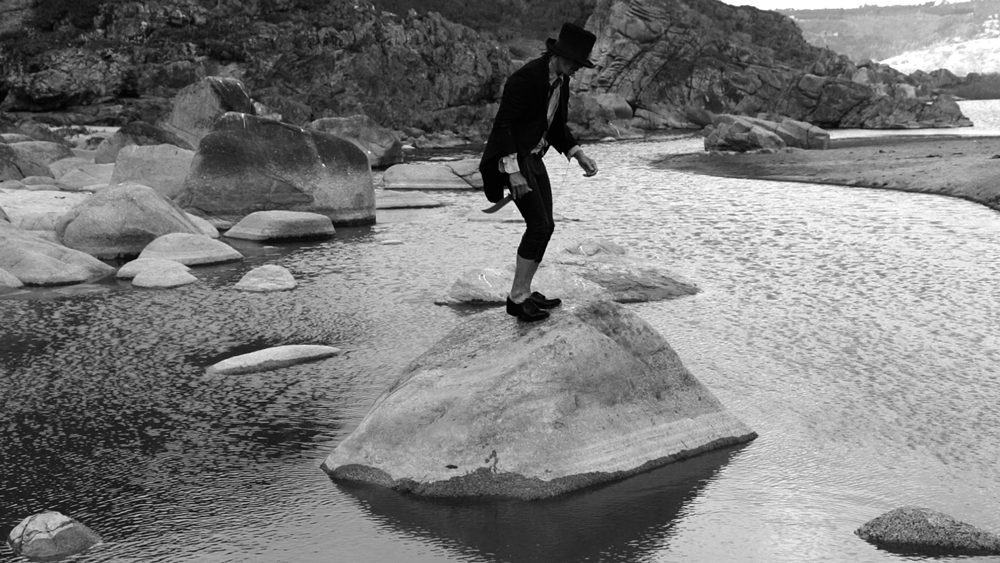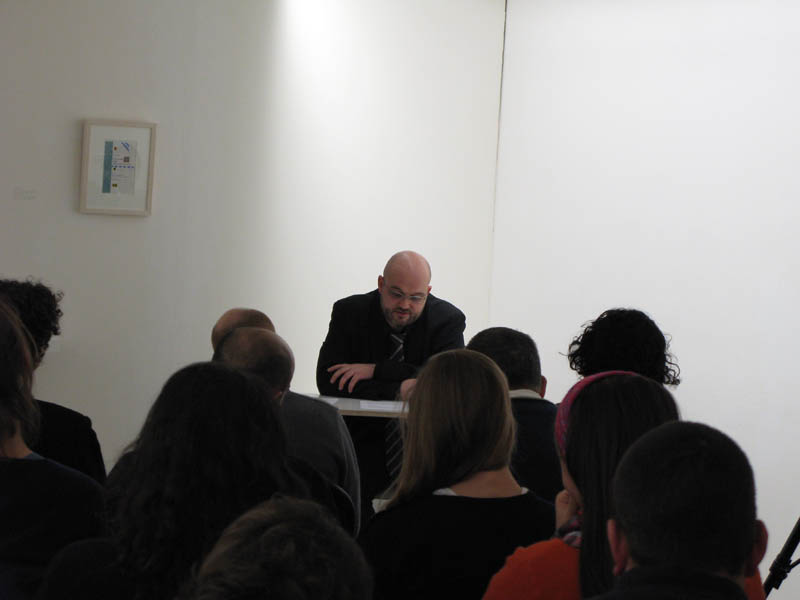
© » KADIST
Liu Yujia
Black Ocean by Liu Yujia portrays a desert landscape in a state of both destruction and construction, revealing the desert’s simultaneous fragility and indestructibility. The structure of the storytelling of this film was inspired by Italian writer Italo Calvino’s novel, Invisible Cities (1972). Several chapters from the book are interwoven in the film incorporating the discussions of cities and landscapes narrated by Marco Polo and Kublai Khan in the novel.

© » KADIST
Sinzo Aanza
Projet d’attentat contre l’image? (Acte 3) by Sinzo Aanza brings together literature and objects in their varied forms. This project stems from the artist’s interest in the syncretism that emerged after Congo’s independence in 1960.

© » KADIST
Thiago Honório
Pau-Brasil is a sculpture by Thiago Honório that references Oswald de Andrade’s 1925 classic of Brazilian modernist literature of the same title. De Andrade’s work demands the resuscitation of “Brazilian” language and culture, advocating for the cultivation of invention and an illogical, “agile and candid” attitude. In response, Honorio’s work takes the physical form of a laquered stalk of the pau brasil tree, from which de Andrade’s work drew its title, piercing the physical form of the book itself.

© » KADIST
Benoît Maire
The piece consists of sculpture of 10 elements, among them: a globe, a picture of a gorilla, a chair, scrabble letters, 3 glasses of black ink, a book whose title is illuminated by the beam of a 8mm projector, a pair of boots, etc. The display is a collection of selected objects chosen in response to the reading of a text by Alain Badiou (the first chapter of the seminar “Le réel est l’impasse de la formalisation; la formalisation est le lieu de passe en force du réel” from February 4, 1975). The elements are a visual way to question the transposition of an idea into reality.

© » KADIST
Liu Chuang
Categorized as low-level literature, a “Love Stories” book is a romantic popular fiction of proletariat China, read mainly by teenagers, students, and young workers. These novels were mostly written by Taiwanese and Hong Kong writers in the 1980s to the 1990s to meet the cultural needs of the new social classes before being imported into China after the Chinese economic reform in the late 1980s. As contemporary China industry developed, a large number of workers became readers of this new pulp fiction.

© » KADIST
Wang Taocheng
Reflection Paper No. 2 is one of four videos in which Wang attempts to accurately illustrate the writings of influential Chinese Eileen Chang, who published her works during the Japanese occupation of China. Image and text reflect on the everyday experiences of women in society, family, marriage, love, and death.

© » KADIST
Martha Colburn
Martha Colburn’s film, Western Wild … or How I Found Wanderlust and Met Old Shatterhand , about the famed German author Karl May weaves together a mixture of stop motion animation, travelogue and biography that generates a kind of sensory wanderlust. Conflating past and present, the film investigates issues of identity and representation, as well as violence and war. The artist considers imagination as an invitation to dream, in order to disrupt the limitations of the everyday context and widen her viewers’ horizons.

© » KADIST
Jason Meadows
Titled afterTruman Capote’s protagonist famously played by Audrey Hepburn in the film Breakfast at Tiffany’s (1961), Holly Golightly (2011) captures the essence of the character: seductive and bold, mysterious and capricious. Though tied to the ceiling by a chain, the suggested figure is literally light on her feet, with a pointed boot hovering just above the gallery floor. Non-parallel lines and inconsistent angles lend the sculpture a sense of airy haphazardness.

© » KADIST
Carlos Amorales
This work, a large oil painting on canvas, shows a moment from Amorales’s eight-minute two-channel video projection Useless Wonder (2006). The video is based on Edgar Allen Poe’s 1838 novel The Narrative of Arthur Gordon Pym of Nantucket. The painting, derived from an image from a different, preexisting work, represents the artist’s continued interest in realizing particular subject matter in alternative forms, thereby imbuing it with new meanings and interpretations.

© » KADIST
Agnieszka Kurant
Drawing & Print (Drawing & Print)
Agnieszka Kurant’s Placebo VIII brings together a series of imaginary pharmaceuticals invented within the fictional narratives of literature and film. Displayed in a custom cabinet, these imaginary drugs are materialized as physical objects, packaged in meticulously designed boxes, listing dosage and description information along with references to the fictional source. Each box is filled with placebo tablets.

© » KADIST
Heman Chong
With a habit of reading eight to ten books at the same time, Chong paints his two-foot tall novel covers through referencing an extensive reading list (accessible on Facebook) he has kept since 2006. Entitled “Bibliography (1): The Lonely Ones,” the list outlines representations of solitude that has been imposed on individuals or communities. Chong divides these archetypes into three over-arching notions: the Hide-away, the Castaway and the Prisoner.

© » KADIST
James Welling
Welling employs simple materials like crumpled aluminum foil, wrinkled fabric and pastry dough and directly exposes them as photograms, playing with the image in the process of revealing it. Although Welling’s approach to photography is more conceptually oriented than poetic, the resulting image in Stowe (a direct photogram of a crumpled piece of cloth) somehow resembles a curtain, perhaps suggesting that an artificial even fictive component in photographic representation. While the curtain might echo other imagery, Welling’s approach is not allegorical but rather abstract in a way that reinforces the materiality of the object.
Heman Chong
- year born: 1977
- gender: male
- nationality: Singaporean
- home town: Muar, Malaysia
James Welling
- location: New York, New York; Los Angeles, California
- year born: 1951
- gender: male
- nationality: American
- home town: Hartford, Connecticut
Martha Colburn
Martha Colburn is known for hand-made animations, which she creates through puppetry, collage, and paint-on-glass techniques...
Jason Meadows
- year born: 1972
- gender: male
- nationality: American
- home town: Indianapolis, Indiana
Liu Yujia
Artist Liu Yujia’s practice revolves mainly around video and photography...
Wang Taocheng
Wang Taocheng is a Shanghai artist who lives and works in Amsterdam...
Carlos Amorales
- year born: 1970
- gender: male
- nationality: Mexican
- home town: Mexico City, Mexico
Sinzo Aanza
Sinzo Aanza is a visual artist, poet, and playwright...
Liu Chuang
Known for engaging socio-economic matters as they relate to urban realities, Liu Chuang proposes different understandings of social systems underlying the everyday...
-
2000-2009
Benoît Maire
2006The piece consists of sculpture of 10 elements, among them: a globe, a picture of a gorilla, a chair, scrabble letters, 3 glasses of black ink, a book whose title is illuminated by the beam of a 8mm projector, a pair of boots, etc...
James Welling
2006Welling employs simple materials like crumpled aluminum foil, wrinkled fabric and pastry dough and directly exposes them as photograms, playing with the image in the process of revealing it...
Carlos Amorales
2007This work, a large oil painting on canvas, shows a moment from Amorales’s eight-minute two-channel video projection Useless Wonder (2006)...
Heman Chong
2009With a habit of reading eight to ten books at the same time, Chong paints his two-foot tall novel covers through referencing an extensive reading list (accessible on Facebook) he has kept since 2006...
-
2010-2019
Jason Meadows
2011Titled afterTruman Capote’s protagonist famously played by Audrey Hepburn in the film Breakfast at Tiffany’s (1961), Holly Golightly (2011) captures the essence of the character: seductive and bold, mysterious and capricious...
Thiago Honório
2014Pau-Brasil is a sculpture by Thiago Honório that references Oswald de Andrade’s 1925 classic of Brazilian modernist literature of the same title...
Liu Chuang
2014Categorized as low-level literature, a “Love Stories” book is a romantic popular fiction of proletariat China, read mainly by teenagers, students, and young workers...
Sinzo Aanza
2017Projet d’attentat contre l’image? (Acte 3) by Sinzo Aanza brings together literature and objects in their varied forms...
Martha Colburn
2017Martha Colburn’s film, Western Wild … or How I Found Wanderlust and Met Old Shatterhand , about the famed German author Karl May weaves together a mixture of stop motion animation, travelogue and biography that generates a kind of sensory wanderlust...
Agnieszka Kurant
Drawing & Print
2018(Drawing & Print) Agnieszka Kurant’s Placebo VIII brings together a series of imaginary pharmaceuticals invented within the fictional narratives of literature and film...







